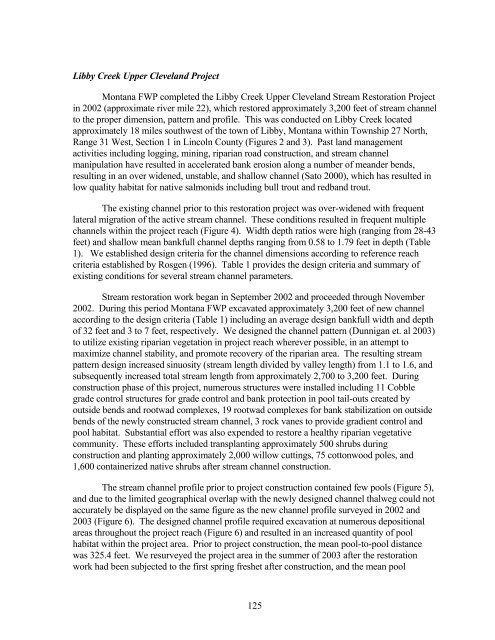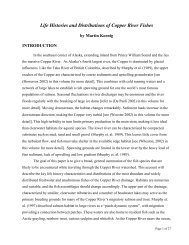Mitigation for the Construction and Operation of Libby Dam
Mitigation for the Construction and Operation of Libby Dam
Mitigation for the Construction and Operation of Libby Dam
Create successful ePaper yourself
Turn your PDF publications into a flip-book with our unique Google optimized e-Paper software.
<strong>Libby</strong> Creek Upper Clevel<strong>and</strong> Project<br />
Montana FWP completed <strong>the</strong> <strong>Libby</strong> Creek Upper Clevel<strong>and</strong> Stream Restoration Project<br />
in 2002 (approximate river mile 22), which restored approximately 3,200 feet <strong>of</strong> stream channel<br />
to <strong>the</strong> proper dimension, pattern <strong>and</strong> pr<strong>of</strong>ile. This was conducted on <strong>Libby</strong> Creek located<br />
approximately 18 miles southwest <strong>of</strong> <strong>the</strong> town <strong>of</strong> <strong>Libby</strong>, Montana within Township 27 North,<br />
Range 31 West, Section 1 in Lincoln County (Figures 2 <strong>and</strong> 3). Past l<strong>and</strong> management<br />
activities including logging, mining, riparian road construction, <strong>and</strong> stream channel<br />
manipulation have resulted in accelerated bank erosion along a number <strong>of</strong> me<strong>and</strong>er bends,<br />
resulting in an over widened, unstable, <strong>and</strong> shallow channel (Sato 2000), which has resulted in<br />
low quality habitat <strong>for</strong> native salmonids including bull trout <strong>and</strong> redb<strong>and</strong> trout.<br />
The existing channel prior to this restoration project was over-widened with frequent<br />
lateral migration <strong>of</strong> <strong>the</strong> active stream channel. These conditions resulted in frequent multiple<br />
channels within <strong>the</strong> project reach (Figure 4). Width depth ratios were high (ranging from 28-43<br />
feet) <strong>and</strong> shallow mean bankfull channel depths ranging from 0.58 to 1.79 feet in depth (Table<br />
1). We established design criteria <strong>for</strong> <strong>the</strong> channel dimensions according to reference reach<br />
criteria established by Rosgen (1996). Table 1 provides <strong>the</strong> design criteria <strong>and</strong> summary <strong>of</strong><br />
existing conditions <strong>for</strong> several stream channel parameters.<br />
Stream restoration work began in September 2002 <strong>and</strong> proceeded through November<br />
2002. During this period Montana FWP excavated approximately 3,200 feet <strong>of</strong> new channel<br />
according to <strong>the</strong> design criteria (Table 1) including an average design bankfull width <strong>and</strong> depth<br />
<strong>of</strong> 32 feet <strong>and</strong> 3 to 7 feet, respectively. We designed <strong>the</strong> channel pattern (Dunnigan et. al 2003)<br />
to utilize existing riparian vegetation in project reach wherever possible, in an attempt to<br />
maximize channel stability, <strong>and</strong> promote recovery <strong>of</strong> <strong>the</strong> riparian area. The resulting stream<br />
pattern design increased sinuosity (stream length divided by valley length) from 1.1 to 1.6, <strong>and</strong><br />
subsequently increased total stream length from approximately 2,700 to 3,200 feet. During<br />
construction phase <strong>of</strong> this project, numerous structures were installed including 11 Cobble<br />
grade control structures <strong>for</strong> grade control <strong>and</strong> bank protection in pool tail-outs created by<br />
outside bends <strong>and</strong> rootwad complexes, 19 rootwad complexes <strong>for</strong> bank stabilization on outside<br />
bends <strong>of</strong> <strong>the</strong> newly constructed stream channel, 3 rock vanes to provide gradient control <strong>and</strong><br />
pool habitat. Substantial ef<strong>for</strong>t was also expended to restore a healthy riparian vegetative<br />
community. These ef<strong>for</strong>ts included transplanting approximately 500 shrubs during<br />
construction <strong>and</strong> planting approximately 2,000 willow cuttings, 75 cottonwood poles, <strong>and</strong><br />
1,600 containerized native shrubs after stream channel construction.<br />
The stream channel pr<strong>of</strong>ile prior to project construction contained few pools (Figure 5),<br />
<strong>and</strong> due to <strong>the</strong> limited geographical overlap with <strong>the</strong> newly designed channel thalweg could not<br />
accurately be displayed on <strong>the</strong> same figure as <strong>the</strong> new channel pr<strong>of</strong>ile surveyed in 2002 <strong>and</strong><br />
2003 (Figure 6). The designed channel pr<strong>of</strong>ile required excavation at numerous depositional<br />
areas throughout <strong>the</strong> project reach (Figure 6) <strong>and</strong> resulted in an increased quantity <strong>of</strong> pool<br />
habitat within <strong>the</strong> project area. Prior to project construction, <strong>the</strong> mean pool-to-pool distance<br />
was 325.4 feet. We resurveyed <strong>the</strong> project area in <strong>the</strong> summer <strong>of</strong> 2003 after <strong>the</strong> restoration<br />
work had been subjected to <strong>the</strong> first spring freshet after construction, <strong>and</strong> <strong>the</strong> mean pool<br />
125
















